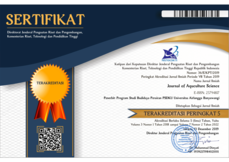Bioflokulan Materials from Carrageenan and Agar on Seaweed Harvesting Process of Phytoplankton Dunaliella salina
Downloads
Harvesting microalgae is an important part in the culture system to produce higher crop biomass. Microalga Harvesting can be done by several techniques such as centrifugation, filtration, sedimentation, flocculation, ultrasonic vibration, and using filter. The technique currently used on an industrial scale is flocculation. This technique is used because it is more quickly and efficiently. Flocculants safe materials are polymers of polysaccharide seaweed. The study was conducted to determine the efficiency of the use of flocculants from alginate, carrageenan, so that the flocculation process microalgae Dunaliella salina. Flocculation process at the 50-minute show flocculation by material alginate by 30.52%, 22.85% by carrageenan, 11 % by Agar, plankton without flocculation make flocculates only amounted to 3.96%. Flocculation process at 240-minutes unchanged where carrageenan increased flocculation becomes 39.84%. Agar increased to 31, 48%. Plankton added flocculant alginate did not experience significant changes that just turned into 30.89%. The research results Show best flocculation activity is carrageenan where flocculation speed equal to alginate that has been frequently used as flocculants.
Keyword : Dunaliella salina, flocculants, Carrageenan, Alginate, Agar
Ariyanti, D. Dan N. A. Handayani. 2010. Mikroalga Sebagai Sumber Biomasa Terbarukan: Teknik Kultivasi dan Pemanenan.Http://Ejournal.Undip.Ac.Id/Index.Php/Metana/Article/View/3431.Volume 06, Nomor 2, Tahun 2010.
Badriyah, L, A.R. Putra, D Saputra, I. Faiqoh, A. H. Nugraha. 2013. Efesiensi Penggunaan Teknik Bioflokulasi dalam Pemanenan Mikroalga Spesies Spirullina Sp. dan Botryococcus Braunii Untuk Optimalisasi Produksi Biodiesel. IPB.
Benemann JR, Oswald WJ. 1996. System and Economic Analysis of Microalgae Ponds for Conversion of CO2 to Biomass. Departement of Energy Pittsburgh Energy Technology Center. PETC Final Report.188.
Jin, E.S. & Melis, A. Biotechnol. Bioprocess Eng. (2003) 8: 331. https://doi.org/10.1007/BF02949276
Kiely, G. 1997. Environment Engineering, Irwin McGraw-Hill, Boston.
Hermawan, J., E. D. Masithah, W. Tjahjaningsih 2 and A. A. Abdillah. 2018. Increasing 펲-carotene content of phytoplankton Dunaliella salina using different salinity media. IOP Conf. Ser.: Earth Environ. Sci. 137 012034.
Salim S, Bosman R, Vermue MH, Wijffels RH. 2011. Harvesting of microalgae by bio-flocculation. J Appl Phycol 23 (2011) 849-855. doi:10.1007/s10811-010-9591-x.
Sim TS, Goh A, Becker EW. 1988. Comparison of Centrifugation, Dissolved Air Flotation and Filtration Technique for Harvesting Sewage-grown Algae. Biomass 16(1988) 51-62. doi:0144-4565/88/$03.50
Thompson R.W., D'Elia, L., Keyser, A., Young, C. 2010. Algae Biodiesel. Faculty Worcester Polytechnic Institute. An Interactive Qualifying Project Report. 47 pp.
Putra, R., B.Lebu, Mhd D. Munthe, A. M. Rambe. 2013. Pemanfaatan biji kelor sebagai koagulan pada proses koagulasi limbah cair industri tahu dengan menggunakan jar test. Jurnal Teknik Kimia USU, Vol. 2, No. 2 (2013).
Pratama, I. 2011. Pengaruh Metode Pemanenan Mikroalga Terhadap Biomassa dan Kandungan Esensial Chlorella vulgaris. Skripsi. Universitas Indonesia. 84 hal.



















